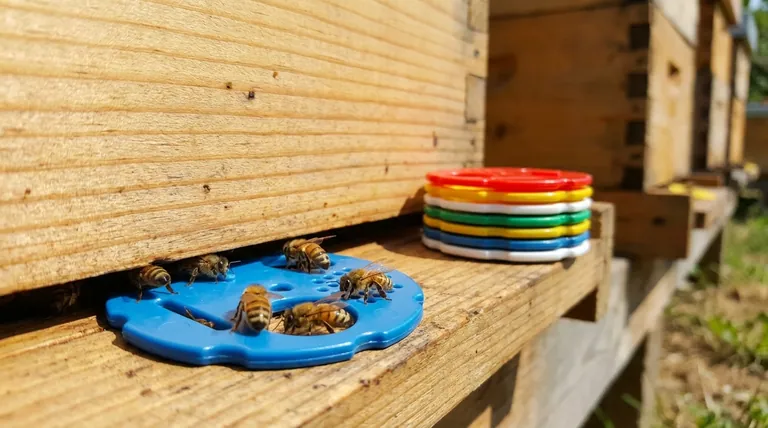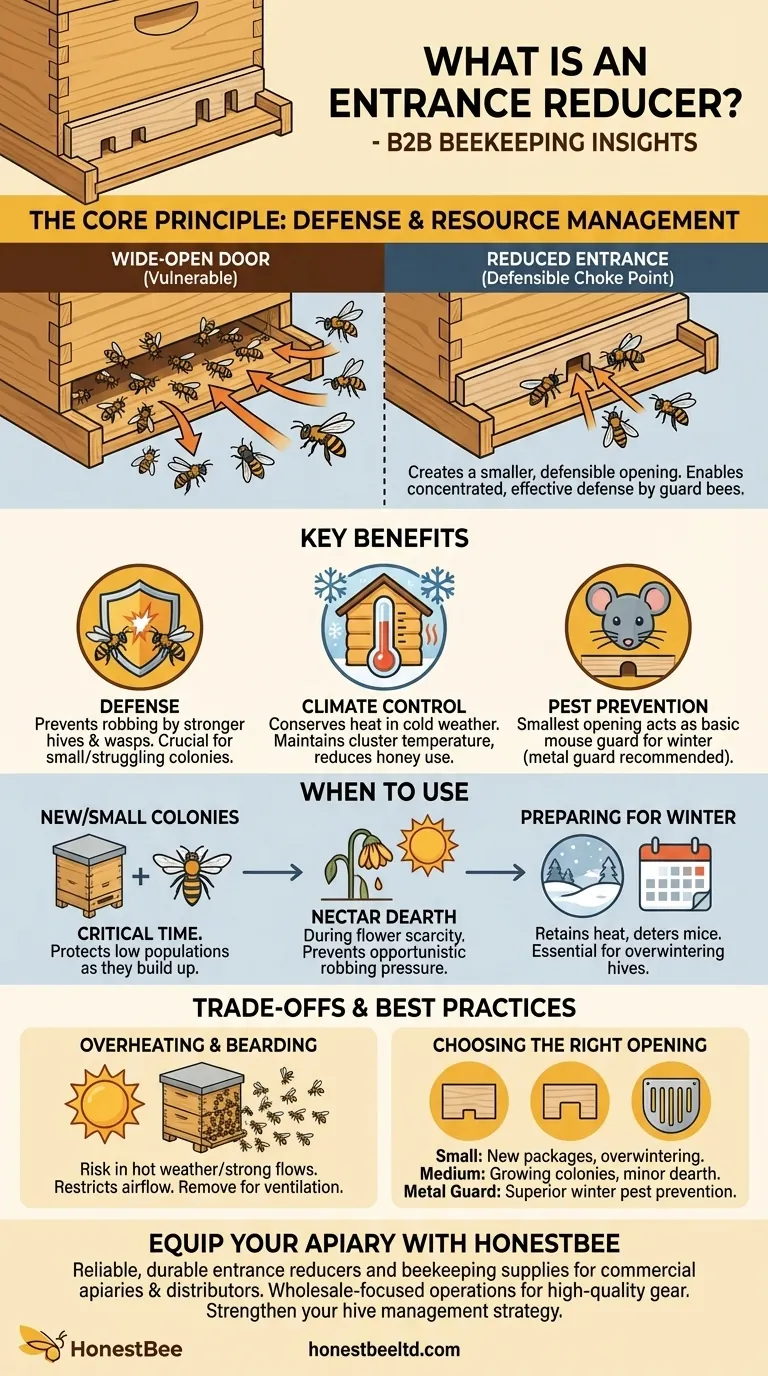At its core, an entrance reducer is a simple wooden block used to shrink the main opening of a beehive. Its primary purpose is to make the entrance smaller, creating a more defensible "choke point" that a small or struggling colony can effectively guard against intruders like robber bees and wasps.
The decision to use an entrance reducer isn't about the tool itself, but about assessing your colony's strength. A reduced entrance is a crucial management technique that trades maximum flight traffic for enhanced security, which is vital for new, weak, or overwintering hives.

The Core Principle: Defense and Resource Management
An entrance reducer is a foundational tool for proactive beekeeping. Its use directly impacts the colony's ability to protect itself and manage its internal environment.
Reducing the "Front Door"
A standard hive entrance is several inches wide to accommodate heavy traffic during a nectar flow. However, for a small colony, this wide-open door is a significant security liability.
By placing an entrance reducer, you physically shrink the space that guard bees must patrol, allowing them to mount a more concentrated and effective defense.
Guarding Against Robbers
The most immediate threat a reducer helps prevent is robbing. This occurs when strong, foraging bees from other hives (or even wasps) discover a weak colony and overwhelm it to steal its honey stores.
A small entrance makes it nearly impossible for a large-scale robbing attack to succeed, as intruders can only enter one or two at a time and are easily dispatched by the guards.
Conserving Heat in Cold Weather
A large, open entrance allows significant heat to escape the hive. During fall and winter, reducing the entrance helps the colony maintain its crucial cluster temperature with less effort and lower honey consumption.
When to Use an Entrance Reducer
Knowing when to use a reducer is just as important as knowing what it does. Its application is directly tied to the colony's population and the time of year.
For New or Small Colonies
This is the most critical time to use an entrance reducer. When you first install a package or a small nucleus hive, the population is low. The reducer gives them the defensive advantage they need to protect their resources while they build up their numbers.
During a Nectar Dearth
A nectar dearth is a period when few flowers are blooming, and outside food sources are scarce. During these times, robbing pressure increases dramatically. Even moderately strong hives can benefit from a reduced entrance to prevent opportunistic attacks.
Preparing for Winter
As the weather cools, a reducer serves two functions. It helps the hive retain heat, and when turned to its smallest opening, it acts as a mouse guard. Mice seek warm, food-filled spaces in the winter and can quickly destroy a hive if they gain entry.
Understanding the Trade-offs and Best Practices
While beneficial, using an entrance reducer improperly can create new problems. Understanding the balance is key to effective management.
The Risk of Overheating and "Bearding"
In hot weather, especially during a strong nectar flow, a reduced entrance can become a major bottleneck. It restricts airflow, which can lead to overheating.
This can also cause "bearding," where a large number of bees cluster on the outside of the hive to cool down, reducing the in-hive workforce. A strong, populous hive in summer generally does not need an entrance reducer.
Choosing the Right Opening Size
Most standard entrance reducers have two different notch sizes, typically a small (1-inch) and a medium (3-inch) opening.
Use the smallest opening for brand new packages, overwintering, or when under active attack from robbers. The medium opening is suitable for growing colonies or during a minor nectar dearth.
Reducers vs. Dedicated Mouse Guards
While a reducer’s smallest opening can deter mice, it is not foolproof. A determined mouse can chew through the wood. For winter, a dedicated metal mouse guard is a far more reliable and durable solution for pest prevention.
Making the Right Choice for Your Hive
The entrance reducer is not a "set it and forget it" tool. It requires you to observe your colony and adapt to its changing needs.
- If you are installing a new package or nucleus hive: Use the smallest opening on your reducer for the first few weeks to give the colony maximum protection as it establishes itself.
- If your hive is strong during a summer nectar flow: Remove the reducer completely to maximize ventilation and prevent traffic jams at the entrance.
- If you are preparing for winter: Install the reducer with the smallest opening or, preferably, use a dedicated metal mouse guard to prevent rodent entry while maintaining ventilation.
Ultimately, using an entrance reducer effectively is a sign of a responsive beekeeper who understands their colony's needs.
Summary Table:
| Purpose | Key Benefit | When to Use |
|---|---|---|
| Defense | Creates a defensible choke point against robber bees and wasps. | New/small colonies, nectar dearth. |
| Climate Control | Conserves heat in cold weather, reducing honey consumption. | Fall and winter preparation. |
| Pest Prevention | Smallest opening can act as a basic mouse guard. | Winter (a dedicated metal guard is better). |
Equip your apiary with the right tools for success.
Proper hive management starts with reliable equipment. At HONESTBEE, we supply durable, well-designed entrance reducers and a full range of beekeeping supplies tailored for the demands of commercial apiaries and beekeeping equipment distributors.
Our wholesale-focused operations ensure you get the high-quality gear you need to protect your investment and promote colony health.
Strengthen your hive management strategy — contact our team today to discuss your wholesale needs.
Visual Guide

Related Products
- Multi-Functional Rotary Hive Entrance Disc for Beekeeping
- Multi-Functional Sliding Hive Entrance for Beekeeping
- HONESTBEE Advanced Ergonomic Stainless Steel Hive Tool for Beekeeping
- HONESTBEE Professional Long Handled Hive Tool with Precision Cutting Blade
- Professional Insulated Winter Hive Wrap for Beekeeping
People Also Ask
- What are the four entrance options provided by the steel entrance disc? Master Hive Traffic & Protection
- How does the outer cover create an upper entrance? Master Hive Ventilation & Congestion Control
- How does entrance configuration vary seasonally for beekeepers? A Guide to Year-Round Hive Health
- What are the applications of the steel entrance disc? A Beekeeper's Guide to Hive Control
- What are the adjustable functions of the circular metal beehive entrance disc? Master Hive Access Control



















